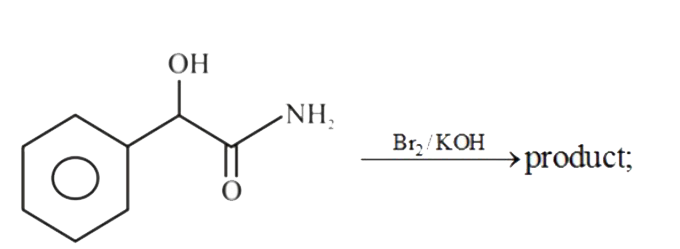Hofmann's Bromamide reaction
Step-by-Step Solution for Hofmann's Bromamide Reaction
Step 1: Identify the Reactants
- The reaction involves a primary amide (RCO-NH2) and bromine (Br2) in the presence of a base (such as NaOH or KOH).
Hint: Remember that only primary amides can undergo the Hofmann bromamide reaction.
---
Step 2: Reaction Setup
- Mix the primary amide with Br2 and the base. The base will deprotonate the amide, making it more reactive.
Hint: The presence of a base is crucial for the reaction to proceed.
---
Step 3: Formation of N-Bromoamide
- The bromine reacts with the primary amide to form an N-bromoamide intermediate (RCO-NHBr).
Hint: Look for the formation of the N-bromo derivative as a key step in the reaction.
---
Step 4: Elimination of Carbon Dioxide
- The N-bromoamide undergoes a rearrangement, leading to the loss of carbon dioxide (CO2) from the carbonyl group (C=O).
Hint: The loss of CO2 is a significant part of the reaction mechanism.
---
Step 5: Formation of Primary Amine
- After the elimination of CO2, the remaining structure is an amine (RNH2). This is the final product of the reaction.
Hint: The final product is a primary amine, which is formed after the loss of CO2.
---
Step 6: Byproduct Formation
- The reaction also produces sodium carbonate (Na2CO3) as a byproduct when the base reacts with the released CO2.
Hint: Byproducts are often overlooked, but they are important for understanding the overall reaction.
---
Summary of Hofmann's Bromamide Reaction
The Hofmann bromamide reaction converts a primary amide into a primary amine through a series of steps involving bromination, rearrangement, and decarboxylation, with sodium carbonate as a byproduct.
- The reaction involves a primary amide (RCO-NH2) and bromine (Br2) in the presence of a base (such as NaOH or KOH).
- Mix the primary amide with Br2 and the base. The base will deprotonate the amide, making it more reactive.
- The bromine reacts with the primary amide to form an N-bromoamide intermediate (RCO-NHBr).
- The N-bromoamide undergoes a rearrangement, leading to the loss of carbon dioxide (CO2) from the carbonyl group (C=O).
- After the elimination of CO2, the remaining structure is an amine (RNH2). This is the final product of the reaction.
- The reaction also produces sodium carbonate (Na2CO3) as a byproduct when the base reacts with the released CO2.
The Hofmann bromamide reaction converts a primary amide into a primary amine through a series of steps involving bromination, rearrangement, and decarboxylation, with sodium carbonate as a byproduct.
Topper's Solved these Questions
Similar Questions
Knowledge Check
Hoffmann bromamide reaction involves conversion of a carboxylic acid amide into an amine with a loss of a carbon atom on treatment with aqueous sodium hypobromite. Thus Hoffmann result in shortening of a carbon chain.
R−O∣∣C−NH2Br2−−−→NaOHR−NH2+NaBr+Na2CO3
Mechanism of the reaction is :

Which of the following will not give Hoffmann bromamide reaction.ACH3−O∣∣C−NH2B C
C D
D
R−O∣∣C−NH2+xNaOH+Br2→R−NH2+2NaBr+Na2CO3+H2O
Number of moles of NaOH used in above Hoffmann bromamide reaction is :A3B4C5D6Hoffmann bromamide reaction involves conversion of a carboxylic acid amide into an amine with a loss of a carbon atom on treatment with aqueous sodium hypobromite. Thus Hoffmann result in shortening of a carbon chain.
R−O∣∣C−NH2Br2−−−→NaOHR−NH2+NaBr+Na2CO3
Mechanism of the reaction is :

Number of moles of NaOH consumed in above reaction.A1B2C3D4
Hoffmann-Bromamide reaction has the following mechanism

The rate-determining step for Hoffmaan-Bromamide reaction is
View SolutionHoffmann-Bromamide reaction has the following mechanism

Reagent used in reaction I is:
View SolutionHoffmann-Bromamide reaction has the following mechanism

The carbonyl group of amide is removed as
View SolutionWrite structures and IUPAC names of
(i) the amide which gives propanamine by Hoffmann bromamide reaction.
(ii) the amine produced by the Hoffmann degradation of benzamide.
View SolutionHoffmann bromamide reaction involves conversion of a carboxylic acid amide into an amine with a loss of a carbon atom on treatment with aqueous sodium hypobromite. Thus Hoffmann result in shortening of a carbon chain.
R−O∣∣C−NH2Br2−−−→NaOHR−NH2+NaBr+Na2CO3
Mechanism of the reaction is :

 Product (A) :
Product (A) :
View Solution

